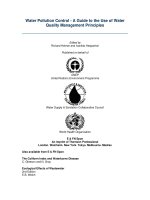Strengthening sme a guide to business management and governance to smes in east africa
Bạn đang xem bản rút gọn của tài liệu. Xem và tải ngay bản đầy đủ của tài liệu tại đây (3.37 MB, 60 trang )
Strengthening SMEs
A Guide to Business Management
and Governance for Small and Medium
Enterprises in East Africa
Wanjohi Ndagu & Richard Obuobi
www.masterpublishing.co.ke
Published by Master Publishing under The CAN-DO! Company
© 2010 African Agricultural Capital and SNV Netherlands
Development Organisation
All rights reserved. No part of this publication may be reproduced,
stored in a retrieval system, or transmitted in any form or by any
means – electronic, mechanical, photocopying, recording, or
otherwise, without the prior written permission of the copyright
owners.
ISBN 9966-05-312-3
Editing and Design: Master Publishing
www.masterpublishing.co.ke
Cover Design and Inside Layout: Jennifer Patricia A Cariño
Cover and Inside Photos: Waweru Ndagu
www.originalimageslimited.com
Reviews
The need for good governance is no longer the preserve of listed companies
because proper management and governance are very important
components of success for all businesses. Today’s SMEs are the economic
leaders of tomorrow, provided they embrace best business practices, so that
real transformation can be realised in our economies. This guide presents
the fundamental practices that an SME needs to employ in order to
attain sustainable growth. It is my hope that the Ugandan business
community will develop a deeper appreciation of good business governance
practices to deliver the desired change.
Sam F Owori
CEO, Institute of Corporate Governance of Uganda
The Kenyan SME sector is going through a transformation; businesses
are venturing into new markets at a fast rate. Management infrastructure
and governance systems, therefore, have to keep up with the pace and
support these changes. Business systems, like many other facets of life in
Kenya, are always catching up, so this guide is both relevant and timely.
Carole Kariuki
CEO, Kenya Private Sector Alliance
As a believer and promoter of best business practices, I think this guide is
a great tool for SMEs. Businesses need to plan for the future; having the
right supporting structures is critical to that.
Dr Evans Rweikiza
Executive Director, Tanzania Private Sector Foundation
Contents
Preface
Acknowledgements
Foreword
Introduction
i
iii
v
vii
Chapter One
Foundations of Business Management and Governance
1
Chapter Two
Business Control Structure
4
Case Study 1
Good African, Uganda
10
Chapter Three
Financial Management
13
Case Study 2
Stantech Motors, Kenya
17
Chapter Four
Benefits of Proper Management and Governance Systems
20
Case Study 3
Eldoville Farm, Kenya
24
Conclusion
27
Annexes
How to Apply Best Practices to Your Business
Sample Agenda Formats
Roles of Board Chairperson and Directors
Online Resources
Organisational Profiles
Authors‟ Profiles
29
30
32
33
34
37
Preface
Most small and medium enterprise (SME) owners across the
world consider business management and governance systems
(or corporate governance) as an issue relevant only to large
companies. In many African countries, the concept is still new
and unfamiliar even to some big companies. African
Agricultural Capital (AAC) and Netherlands Development
Organisation (SNV), though, see it as important to the
development of SMEs in the East African region.
When we searched for existing SME-friendly resources on
corporate governance, we discovered that the only available
materials and training programmes were more appropriate for
larger corporations and/or developed-world contexts. They
did not meet the unique needs and challenges of SMEs in the
African context. AAC and SNV then decided to create this
guide specifically for SME owners, to promote best practices
in business management and governance among them.
In this guide, we endorse management and governance
systems as a key ingredient for a successful and stable
business. We encourage SMEs to establish appropriate
systems and to avoid the common ‘one-man show’ approach
among them. We show them the relative ease of achieving
such a positive development just by making a few changes in
how they manage their businesses. To help them, we present
best practices and benefits of proper management and
governance systems, along with business case studies about
their fellow SMEs that have successfully applied them.
As part of our preparation for this book, we did a baseline
survey to determine the acceptability and implementation of
proper business management and governance. The study
included 111 SMEs from Kenya, Tanzania, and Uganda. We
discuss the results in the introduction.
i
In the end, we hope that this guide accomplishes the reason
for which it was written: to strengthen SMEs in the East
African region.
Wanjohi Ndagu and Richard Obuobi
ii
Strengthening SMEs
Acknowledgements
On behalf of our organisations (AAC and SNV), we are
grateful to the Aspen Network of Development
Entrepreneurs (ANDE), a network of funders, intermediaries,
and experts, dedicated to unleashing the potential of small
businesses in the developing world. ANDE provided the grant
that made this guide possible.
Special thanks go to consultants Ms Sarah Kanaiya, Mr
Sosthenes Aloyse Sambua, and Dr Jeff Sebuyira-Mukasa, for
conducting baseline surveys and developing case studies in
Kenya, Tanzania, and Uganda respectively.
We also thank the SMEs that allowed us to use details of their
best management and governance practices: Eldoville Farm,
Lachlan Agriculture, and Stantech Motors, in Kenya; Buturi
Investments Limited, Lahamat Limited, and Universal Group
Limited, in Tanzania; and Good African, Micro Enterprise
Development Network, and Uganda National Agro-Input
Dealers’ Association, in Uganda.
We offer our gratitude to Tom Adlam, AAC managing
director, and Reuben Coffie, SNV senior regional investment
advisor of East and Southern Africa, who provided valuable
guidance and support to this book project. We are also
grateful to Seungchul Seo, for his involvement in the initial
stages of the work.
Finally, we thank Agatha Verdadero, managing editor of
Master Publishing, whose company provided editing and
design services; Jennifer Patricia A Cariño for the cover design
and inside layout; Waweru Ndagu of Original Images, for the
cover and inside photos; and all field staff who assisted with
interviews and data collection.
iii
Foreword
The SME sector in East Africa and Africa in general has undergone
tremendous transformation over the years. It has been my great source of
gratification and pride to witness and be part of this process. The business
environment has improved significantly and, in the process, unlocked the
great potential of the business community. As the East African common
market is put into operation, business opportunities are likely to follow.
In all this, SMEs stand to benefit immensely.
In my extensive work with businesses, and with SMEs in particular, I
have noted the need for strengthening management and governance
systems. It is important for a business to demonstrate that it is
professionally run in order to access credit and gain the confidence of its
diverse stakeholders. Past performance and business practices are key
factors in measuring risk by financiers. Financiers will view a business
more favourably if it has a track record of having systems and controls,
such as those addressed in this guide.
SMEs should start setting up these systems early in their lives, so that
these become part of the company culture. Simple things like budgeting,
preparing management accounts, and holding regular and structured
board meetings have the potential of significantly improving a company’s
efficiency.
SMEs should anticipate growth and change early by equipping themselves
with some of the fundamental practices detailed in this guide. Systems and
proper management and succession structures should form the backbone of
organisations.
I am delighted to have been invited to provide a foreword for this guide. I
am a firm believer in the immense value that SMEs can bring to the
growth and development of our economies and people, if properly nurtured.
Martin Oduor-Otieno
Chief Executive, Kenya Commercial Bank Group
Nairobi, Kenya • September 2010
v
vi
Strengthening SMEs
Introduction
Better-governed companies have less management problems.
They act on and recover from shocks more quickly, so they
achieve faster and more reliable growth. Still, most SME
owners across the world consider corporate governance
relevant only to large companies. It is more prevalent in
Africa, where the concept is still unfamiliar even to relatively
large SMEs.
All businesses, regardless of size or nature, have systems of
management and governance. How much business owners
implement them is influenced by culture, education, type of
business, business environment, and other similar factors. In
the end, SME owners agree on their need for systems because
they need a method to the management of their businesses, if
they are to achieve their goals.
Business management and governance systems in East Africa
and the rest of the continent have been in existence for a long
time now. Some of the most progressive and observed ones
are in land ownership and transfer. The main difference
between old and current systems is the increased importance
of written records. In the last 20 years, technology has had an
increasingly significant impact on management and
governance. Businesses in East Africa have come a long way
since pre-colonial days, when transactions were rare. Today,
average businesses transact multiple times daily, which make it
necessary to create better management and governance
systems to keep up accurately with business activities.
Until recent decades, most East African SMEs were limited in
growth due to lack of systems. Traditionally, SME owners
expanded only up to a size that they could still personally and
actively manage on a daily basis. Nowadays, though, SMEs
develop at a fast rate in the form of branches, franchises,
partnerships, etc. The integration of the East African
Community into a common market also presents new
vii
openings for them in the form of regional expansion for their
businesses.
Big corporations have a much deeper appreciation for proper
management and governance systems because they consider
them very important to their success. It is no wonder that they
can explore opportunities in one corner of the world and
manage them from another. SMEs should have the same
attitude towards business management and governance
systems in order to develop themselves.
A Definition of Business Management and Governance
For the purpose of this guide, we will refer to “corporate
governance” as “business management and governance
systems” (and other derived phrases) because SMEs generally
do not consider themselves „corporate‟. However, the
meaning remains the same: It is the method by which
companies, big and small, are run and kept in check.
Survey on Management and Governance Systems Among
SMEs in East Africa
We carried out a survey to establish the acceptance and
application of management and governance systems among
SMEs in East Africa. With our consultants‟ assistance, we
covered 111 SMEs in Kenya (38), Tanzania (25), and Uganda
(48), from all economic sectors with special emphasis on
agribusiness. The results indicated that SMEs tend to have
some systems in place, especially at leadership level, but not
much at internal levels. A major challenge in the survey
process was the unwillingness of business owner-managers to
reveal company information because of privacy concerns and
a lack of knowledge of these systems.
viii Strengthening SMEs
Survey Highlights
Kenya
•
•
•
•
•
•
•
•
•
87 percent of SME respondents reported
improved performances in their businesses
after adopting proper management and
governance systems; they either attracted
investment capital or grew fast.
54 percent had shareholders‟/partners‟
agreements in place.
Most of them had a functioning board of
directors.
71 percent prepared annual budgets, which
were then voted on by the directors or
partners.
Human resources policies and controls were
more widely implemented among them than
financial controls were.
They prepared management accounts, although
their frequency varied from each other. Most
of them prepared monthly accounts, but some
did them less frequently (quarterly and
annually).
Slightly over 50 percent had procurement
procedures.
66 percent of them had a written code of
ethics, which was familiar to their staff who
they expected would follow it.
Generally, they applied many best practices of
management and governance in their
operations but not in a consistent manner.
Tanzania
•
60 percent of surveyed businesses had a
functioning board of directors. The companies
with boards conducted regular board meetings
and kept records of them.
Introduction
ix
•
•
•
•
•
33 percent documented their business plans,
which was a matter of concern because most
of them were managed by just one or two
people with an unclear succession plan.
At the management level, they were aware of
and followed good management principles.
60 percent prepare audited accounts, which
they shared with their respective boards.
13 percent had operations manuals and
conducted staff appraisals, which showed a
weakness in human resources management.
67 percent held regular management meetings.
Uganda
•
•
•
•
x
Regarding management and governance
systems, SME respondents registered average
ratings on issues of ethics, the equitable
treatment of stakeholders and organisational
structure. Similar results showed regarding the
board‟s roles and responsibilities as well as
reporting, disclosure, and transparency.
They considered governance and management
systems important to their organisation‟s
development and performance.
They thought financial constraints forced them
to prioritise specific practices and to neglect
others that were equally important to their
business success.
The result of the survey recommended that
SME boards should put more emphasis on the
board‟s roles in the organisational structure, for
example, setting of budgets and targets and the
development of operational procedures and
manuals.
Strengthening SMEs
Survey Conclusions
The establishment of strong management and governance
systems were hindered due to the following key factors:
•
•
•
•
Unawareness of their importance and
benefits,
Financial and time constraints,
Misconception of the value added by nonexecutive directors to the business, and
Negative impact of directors‟ fees on the
SMEs‟ availability of cash.
However, most business owners in the region appreciated the
effect of management and governance systems on their
businesses' performance. They also showed willingness to
learn more about business governance.
Introduction
xi
Chapter One
Foundations of Business
Management and Governance
The foundations of sound management and governance
systems are accountability, proper decision-making process,
fairness and equity, and transparency. There is a strong link
between these four elements and business performance and
endurance.
Accountability
A good management and governance system provides a high
degree of accountability to its shareholders and other
interested parties. This means managerial and operational
problems are easily identified and solved. Accountability is
achieved mainly through the establishment of a clear chain of
command and distribution of duties.
Proper Decision-making Process
Management and governance systems are viewed as a process
of decision making and application. Decisions in an
organisation are best achieved with the availability of proper
information and wide participation. Proper systems provide an
effective method of arriving at decisions through the
contributions of all interested parties and a reliable channel of
communicating the said decisions.
Fairness and Equity
The organisation‟s well-being benefits from how much its
members achieve a feeling of inclusiveness. Shareholders and
directors, who are not part of daily operations, need to be
involved through timely and accurate reports. Employees
should feel that their contributions are important to the
company‟s overall goals, so they could perform better. A
system that gives employees clear responsibilities and
1
acknowledgement for their performance can make them more
dedicated and productive in their jobs.
Transparency
Management and governance systems play a major role in
promoting transparency. Proper and clear reporting is
important to ensure that information is available to all parties
concerned. Rules and regulations in the organisation are also
understood and followed because of the organisation‟s
openness.
Figure 1.1 Foundations of Business Management and Governance
In the following chapters, we discuss best practices of
governance systems. Good management and governance
systems need to abide by these four basic standards: business
control structure, budgeting and cash management,
management accounts, and annual audit. They are widely
viewed as necessary to establish a reliable organisation.
Businesses can customise them according to their needs,
without compromising on their essence as best practices.
Their respective objectives are:
2
Strengthening SMEs
•
•
•
•
Business Control Structure: Ensure accountability to all
stakeholders and manage relationships with shareholders,
the board, management, staff, and other parties.
Budgeting and Cash Management: Instil the discipline of
planning, for both profitability and working capital
adequacy.
Management Accounts: Keep a close eye on actual income
and expenditure against the budget.
Annual Audit: Assure anybody of the reliability of
management and financial records and provide an
outsider‟s expert assessment of a company‟s internal
control system.
Points for SME Owners and Managers to Think About
1.
2.
3.
Are these foundations in the value system of my
business?
Does my business management system reflect these
foundations?
What steps should I take to put the missing
foundation/s in place?
Chapter One: Foundations of Business Management and Governance
3
Chapter Two
Business Control Structure
The main purpose of a control structure is to allocate
responsibilities and functions to various company units and
positions. A good structure brings order to an organisation. It
provides a guide on how one unit should relate to another, in
order to establish efficiency in operations and effectiveness in
decision making. It sets out a chain of command for all
company employees. SMEs may not need complicated
structures such as those adopted by big corporations, but they
should establish one that fits their operations and which they
can enhance as they grow. An effective organisational
structure considers the needs and contributions of the
following:
Shareholders
Business owners or shareholders are the main interested
parties in the control structure because they usually start the
business themselves and are the biggest investors. The entire
structure is designed to be accountable to them because they
have the right of control of the business and its returns and
are ultimately responsible for everything within the company.
Shareholders set up businesses to serve their interests, so
every unit in the structure, including the board and
management, have to work towards this objective.
4
The main function of shareholders in a large-business
structure is to appoint a board. In SMEs, however, they are
involved in more roles than that. In most cases, they also
manage their businesses, which can be an asset because they
have a special commitment to the success of the business, as
owners. In addition, many of them are actually very skilled in
management.
Even under SME conditions, though, the respective roles of
shareholders and management have to be defined. Good
shareholders should be able to review the management‟s
performance objectively, even if they may be a part of it. They
should be courageous enough to ask themselves if they are the
best managers for their business. If they are not, they should
give up that role. They should also be professional enough
and hold annual general meetings and demand audited
accounts to be given in a timely manner, which they should
review as a measure of their business success.
Company Board
This guide refers to a board as a formal group that is a
permanent part of the organisational structure. It meets
regularly and has clear responsibilities. Most SMEs associate
boards with big corporations mainly because they view
themselves as too small for such bureaucracies.
SMEs need to appreciate boards for their roles and
contributions to the business. A board‟s composition should
initially not be a major concern to SMEs as long as it
functions effectively. Should the business require external
expert advice, the board can expand to accommodate such
individuals. Another strength of external experts is that they
are less involved in the managing of the business and are not
directly affected by decisions, so they have the potential of
being more objective. Otherwise, the owners and senior
management can serve effectively on the board, with external
auditors as advisers on financial and internal control matters.
Chapter Two: Business Control Structure
5









